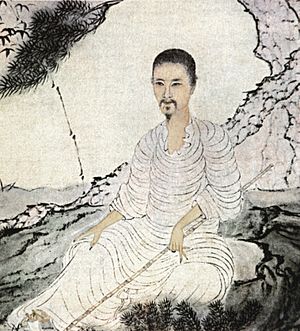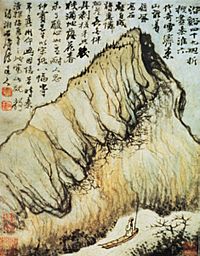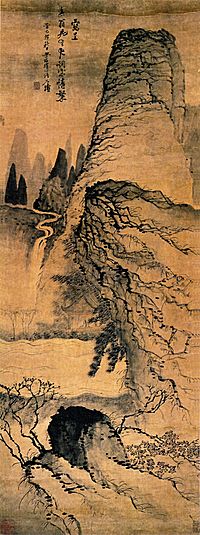Shitao facts for kids
Shitao, also known as Shi Tao, was a famous Chinese artist who lived a long time ago, from 1642 to 1707. He was a Buddhist monk, a great writer (calligrapher), and especially known for his amazing landscape paintings. His real name was Zhu Ruoji, and he was even related to the royal family of the Ming dynasty!

When the Ming dynasty ended in 1644, Shitao was very young. He managed to escape danger and later became a Buddhist monk, changing his name to Yuanji Shitao.
He traveled a lot in China, living in places like Wuchang, Anhui, Nanjing, and Yangzhou. He even went to Beijing to try and find support for his religious work. When that didn't work out, he decided to follow a different path, Daoism, and went back to Yangzhou. He lived there until he passed away. It's said he even met the Kangxi Emperor once!
Contents
What's in a Name? Shitao's Many Titles
Shitao had many different names during his life, more than two dozen! These names often showed his feelings about his family history.
Some of his most common names were:
- Shitao (meaning "Stone Wave")
- Daoji
- Kugua Heshang (meaning "Bitter Gourd Monk")
- Yuan Ji (meaning "Origin of Salvation")
- Xia Zunzhe (meaning "Honorable Blind One," which meant he was "blind" to worldly desires)
- Da Dizi (meaning "The Cleansed One")
When he became a Buddhist monk, he was known as Yuan Ji. Later, when he changed from Buddhism to Daoism, he took the name Da Dizi. He even named his home in Yangzhou "Da Di Hall" after this name.
Shitao's Unique Art Style
Shitao was one of the most famous and unique painters of his time, during the early Qing dynasty. His art was very new and different. Back then, artists often copied older styles, but Shitao wanted to create something fresh. While he learned from earlier artists, his paintings broke away in exciting ways.
He made his paintings special by showing the act of painting itself. He used washes of color and bold, strong brushstrokes that looked almost like modern art. He also played with perspective, making some parts look far away by using empty white spaces.
Shitao had a very strong belief about his art. He once wrote: "If someone asks whether I [Shitao] follow the Southern or the Northern School, or whether either school follows me, I hold my belly laughing and reply, 'I always use my own method!'" This shows how much he believed in his own unique way of painting.
He also wrote books about his ideas on art, like Sayings on Painting from Monk Bitter Gourd. He often talked about using a "single brushstroke" as the basic idea for all his paintings. You can see this in the thin, flowing lines in his artwork. The large empty areas in his paintings also make his style stand out.
His poems and beautiful writing (calligraphy) that went with his paintings were just as creative and lively. Shitao's art shows the struggles of scholar-artists who wanted to be free from old rules.
The 10,000 Ugly Inkblots Painting

The painting called 10,000 Ugly Inkblots is a great example of Shitao's playful and surprising art ideas. This artwork challenges what people usually think is beautiful. At first, it looks like a carefully painted landscape. But then, it turns into splatters of ink, almost like modern abstract art.
This makes you realize that the painting isn't just a simple picture. Because the ink dots are called "ugly," they start to look beautiful in their own abstract way.
Reminiscences of Qinhuai and Nature
The Reminiscences of Qinhuai is another one of Shitao's very special paintings. Like many artworks from his time, it explores how humans fit into nature. When you first look at it, the rocky mountain in the painting seems a bit strange. What makes this painting so unique is that the mountain appears to be bowing!
A monk stands calmly on a boat floating on the Qinhuai River, looking up in wonder at the bowing stone giant. This painting shows a deep respect between humans and nature in a very clever way. It reminds some people of surrealism or magical realism, where things are dreamlike or a bit absurd.
Shitao himself had visited the Qinhuai River area in the 1680s. We don't know if this painting shows a real place, but it certainly captures a feeling of mutual respect. Shitao painted other "reminiscences" like this, including "Reminiscences of Nanjing," which helped make his art famous.
Images for kids
-
Shitao, Master Shi Planting Pines, c. 1674, ink and color on paper, National Palace Museum.
-
Reminiscences of Qin-Huai by Shitao, Cleveland Museum of Art.
See also
 In Spanish: Shitao para niños
In Spanish: Shitao para niños




